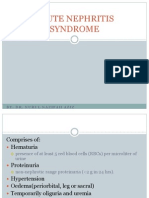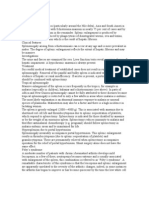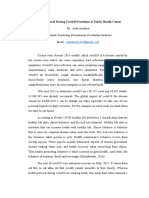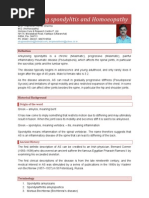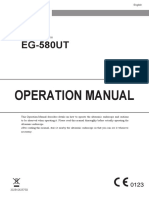0 ratings0% found this document useful (0 votes)
100 viewsWhat Is Acute Glomerulonephritis?: Acute Glomerulonephritis (GN) Comprises A Specific Set of Renal Diseases in
What Is Acute Glomerulonephritis?: Acute Glomerulonephritis (GN) Comprises A Specific Set of Renal Diseases in
Uploaded by
Annapoorna SHAcute glomerulonephritis (AGN) is a sudden onset kidney disease caused by an immune response, often to a streptococcal infection, that results in inflammation and proliferation of glomerular tissue and damage to the basement membrane. It is characterized by hematuria, proteinuria, and red blood cell casts in the urine. Treatment is supportive and focuses on fluid restriction, blood pressure control with diuretics or vasodilators, and antibiotics to treat any infection. Nursing care for AGN involves careful monitoring of fluid balance, breathing, nutrition, and skin integrity given the risks of fluid overload, infection, and impaired healing.
Copyright:
© All Rights Reserved
Available Formats
Download as DOCX, PDF, TXT or read online from Scribd
What Is Acute Glomerulonephritis?: Acute Glomerulonephritis (GN) Comprises A Specific Set of Renal Diseases in
What Is Acute Glomerulonephritis?: Acute Glomerulonephritis (GN) Comprises A Specific Set of Renal Diseases in
Uploaded by
Annapoorna SH0 ratings0% found this document useful (0 votes)
100 views6 pagesAcute glomerulonephritis (AGN) is a sudden onset kidney disease caused by an immune response, often to a streptococcal infection, that results in inflammation and proliferation of glomerular tissue and damage to the basement membrane. It is characterized by hematuria, proteinuria, and red blood cell casts in the urine. Treatment is supportive and focuses on fluid restriction, blood pressure control with diuretics or vasodilators, and antibiotics to treat any infection. Nursing care for AGN involves careful monitoring of fluid balance, breathing, nutrition, and skin integrity given the risks of fluid overload, infection, and impaired healing.
Original Title
AGN
Copyright
© © All Rights Reserved
Available Formats
DOCX, PDF, TXT or read online from Scribd
Share this document
Did you find this document useful?
Is this content inappropriate?
Acute glomerulonephritis (AGN) is a sudden onset kidney disease caused by an immune response, often to a streptococcal infection, that results in inflammation and proliferation of glomerular tissue and damage to the basement membrane. It is characterized by hematuria, proteinuria, and red blood cell casts in the urine. Treatment is supportive and focuses on fluid restriction, blood pressure control with diuretics or vasodilators, and antibiotics to treat any infection. Nursing care for AGN involves careful monitoring of fluid balance, breathing, nutrition, and skin integrity given the risks of fluid overload, infection, and impaired healing.
Copyright:
© All Rights Reserved
Available Formats
Download as DOCX, PDF, TXT or read online from Scribd
Download as docx, pdf, or txt
0 ratings0% found this document useful (0 votes)
100 views6 pagesWhat Is Acute Glomerulonephritis?: Acute Glomerulonephritis (GN) Comprises A Specific Set of Renal Diseases in
What Is Acute Glomerulonephritis?: Acute Glomerulonephritis (GN) Comprises A Specific Set of Renal Diseases in
Uploaded by
Annapoorna SHAcute glomerulonephritis (AGN) is a sudden onset kidney disease caused by an immune response, often to a streptococcal infection, that results in inflammation and proliferation of glomerular tissue and damage to the basement membrane. It is characterized by hematuria, proteinuria, and red blood cell casts in the urine. Treatment is supportive and focuses on fluid restriction, blood pressure control with diuretics or vasodilators, and antibiotics to treat any infection. Nursing care for AGN involves careful monitoring of fluid balance, breathing, nutrition, and skin integrity given the risks of fluid overload, infection, and impaired healing.
Copyright:
© All Rights Reserved
Available Formats
Download as DOCX, PDF, TXT or read online from Scribd
Download as docx, pdf, or txt
You are on page 1of 6
Acute glomerulonephritis (GN)
comprises a specific set of renal diseases in
which an immunologic mechanism triggers inflammation and proliferation of
glomerular tissue that can result in damage to the basement membrane,
mesangium, or capillary endothelium.
What is Acute Glomerulonephritis?
.Acute glomerulonephritis (GN) comprises a specific set of renal diseases in
which an immunologic mechanism triggers inflammation and proliferation of
glomerular tissue that can result in damage to the basement membrane,
mesangium, or capillary endothelium.
Acute GN is defined as the sudden onset of hematuria,
proteinuria, and red blood cell (RBC) casts in the urine.
Acute GN is a condition that appears to be an allergic reaction to
a specific infection, most often group A beta-hemolytic
streptococcal infection.
Pathophysiology
Acute Glomerulonephritis involves both structural changes and functional
changes.
Structurally, cellular proliferation leads to an increase in the
number of cells in the glomerular tuft because of the proliferation
of endothelial, mesangial, and epithelial cells.
The proliferation may be endocapillary (i.e., within the confines of
the glomerular capillary tufts) or extracapillary (ie, in the Bowman
space involving the epithelial cells).
In extracapillary proliferation, proliferation of parietal epithelial
cells leads to the formation of crescents, a feature characteristic of
certain forms of rapidly progressive GN.
Leukocyte proliferation is indicated by the presence of neutrophils
and monocytes within the glomerular capillary lumen and often
accompanies cellular proliferation.
Glomerular basement membrane thickening appears as
thickening of capillary walls on light microscopy.
Electron-dense deposits can be subendothelial, subepithelial,
intramembranous, or mesangial, and they correspond to an area
of immune complex deposition.
Hyalinization or sclerosis indicates irreversible injury.
These structural changes can be focal, diffuse or segmental, or
global.
Functional changes include proteinuria, hematuria, reduction in
GFR (ie, oliguria or anuria), and active urine sediment with RBCs
and RBC casts.
The decreased GFR and avid distal nephron salt and water
retention result in expansion of intravascular volume, edema, and,
frequently, systemic hypertension.
Statistics and Incidences
Acute Glomerulonephritis represents 10-15% of glomerular diseases.
Acute GN has a peak incidence in children 6 to 7 years of age and
occurs twice as often in boys.
Worldwide, IgA Nephropathy (Berger disease) is the most
common cause of GN.
Postinfectious GN can occur at any age but usually develops in
children.
Most cases occur in patients aged 5-15 years; only 10% occur in
patients older than 40 years.
Acute GN predominantly affects males (2:1 male-to-female ratio).
Causes
The causal factors that underlie acute GN can be broadly divided into
infectious and noninfectious groups.
Infectious. The most common infectious cause of acute GN is
infection by Streptococcus species (ie, group A, beta-hemolytic).
Noninfectious. Noninfectious causes of acute GN may be divided
into primary renal diseases, systemic diseases, and miscellaneous
conditions or agents.
Clinical Manifestations
Presenting symptoms appear 1 to 3 weeks after the onset of a
streptococcal infection.
Hematuria. Usually the presenting symptom is grossly bloody
urine; the caregiver may describe the urine as smoky or bloody.
Periorbital edema. Periorbital edema and/or pedal edema may
accompany or precede hematuria.
Fever. Fever may be 103°F to 104°F at the onset but decreases in
a few days to about 100°F.
Hypertension. Hypertension occurs in 60% to 70% of patients
during the first 4 or 5 days.
Oliguria. Oliguria (production of a subnormal volume of urine) is
usually present, and the urine has a high specific gravity and
contains albumin, red and white blood cells, and casts.
Fluid overload. Observe for periorbital and/or pedal edema;
edema and hypertension due to fluid overload (in 75% of
patients); crackles (ie, if pulmonary edema); elevated jugular
venous pressure; ascites and pleural effusion (possible).
Cerebral symptoms. Cerebral symptoms consisting mainly of
headache, drowsiness, convulsions, and vomiting occur in
connection with hypertension in a few cases.
Assessment and Diagnostic Findings
There are a lot of renal syndromes that may mimic the symptoms of acute GN,
so accurate assessment and diagnosis is essential.
Initial blood tests. A CBC is performed; a decrease in the
hematocrit may demonstrate a dilutional anemia; in the setting of
an infectious etiology, pleocytosis may be evident; electrolyte
levels are measured (particularly the serum potassium), along with
BUN and creatinine (to allow estimation of the glomerular
filtration rate [GFR]); the BUN and creatinine levels will exhibit a
degree of renal compromise and GFR may be decreased.
Complement levels. Differentiation of low and normal serum
complement levels may allow the physician to narrow the
differential diagnosis.
Urinalysis. The urine is dark; its specific gravity is greater than
1.020; RBCs and RBC casts are present; and proteinuria is
observed.
Streptozyme tests. The streptozyme tests test includes many
streptococcal antigens that are sensitive for screening but are not
quantitative, such as DNAase, streptokinase, streptolysin O, and
hyaluronidase; the antistreptolysin O (ASO) titer is increased in
60-80% of patients; increasing ASO titers or streptozyme titers
confirm recent infection.
Blood and tissue cultures. Blood culture is indicated in patients
with fever, immunosuppression, intravenous (IV) drug use history,
indwelling shunts, or catheters; cultures of throat and skin lesions
to rule out Streptococcus species may be obtained.
Medical Management
Treatment of acute glomerulonephritis (AGN) is mainly supportive, because
there is no specific therapy for renal disease.
Diet. Sodium and fluid restriction should be advised for treatment
of signs and symptoms of fluid retention (eg, edema, pulmonary
edema); protein restriction for patients with azotemia should be
advised if there is no evidence of malnutrition.
Activity. Bed rest is recommended until signs of glomerular
inflammation and circulatory congestion subside as prolonged
inactivity is of no benefit in the patient recovery process.
Long term monitoring. Long-term studies on children with AGN
have revealed few chronic sequelae.
Pharmacologic Management
The goals of pharmacotherapy are to reduce morbidity, to prevent
complications, and to eradicate the infection.
Antibiotics. In streptococcal infections, early antibiotic therapy
may prevent antibody response to exoenzymes and render throat
cultures negative, but may not prevent the development of AGN.
Loop diuretics. Loop diuretics decrease plasma volume and
edema by causing diuresis. The reductions in plasma volume and
stroke volume associated with diuresis decrease cardiac output
and, consequently, blood pressure.
Vasodilators. These agents reduce systemic vascular resistance,
which, in turn, may allow forward flow, improving cardiac output.
Calcium channel blockers. Calcium channel blockers inhibit the
movement of calcium ions across the cell membrane, depressing
both impulse formation (automaticity) and conduction velocity.
Nursing Management
The nurses’ role in the care of a child with AGN is crucial.
Nursing Assessment
Assessment of a child with AGN include:
Physical examination. Obtain complete physical assessment
Assess weight. Monitor daily weight to have a measurable
account on the fluid elimination.
Monitor intake and output. Monitor fluid intake and output
every 4 hours to know progressing condition via glomerular
filtration.
Assess vital signs. Monitor BP and PR every hour to know
progression of hypertension and basis for further nursing
intervention or referral.
Assess breath sounds. Assess for adventitious breath sounds to
know for possible progression in the lungs.
Nursing Diagnoses
Based on the assessment data, the major nursing diagnoses are:
Ineffective breathing pattern related to the inflammatory
process.
Altered urinary elimination related to decreased bladder
capacity or irritation secondary to infection.
Excess fluid volume related to a decrease in regulatory
mechanisms (renal failure) with the potential of water.
Risk for infection related to a decrease in the immunological
defense.
Imbalanced nutrition less than body requirements related to
anorexia, nausea, vomiting.
Risk for impaired skin integrity related to edema and pruritus.
Hyperthermia related to the ineffectiveness of thermoregulation
secondary to infection.
Nursing Care Planning and Goals
Nursing care planning goals for a child with acute glomerulonephritis are:
Excretion of excessive fluid through urination.
Demonstration of behaviors that would help in excreting
excessive fluids in the body.
Improvement of distended abdominal girth.
Improvement of respiratory rate.
Participation and demonstration of various ways to achieve
effective tissue perfusion.
Nursing Interventions
Nursing care of a child with AGN includes the following interventions:
Activity. Bed rest should be maintained until acute symptoms
and gross hematuria disappear.
Prevent infection. The child must be protected from chilling and
contact with people with infections.
Monitor intake and output. Fluid intake and urinary output
should be carefully monitored and recorded; special attention is
needed to keep the intake within prescribed limits.
Monitor BP. Blood pressure should be monitored regularly using
the same arm and a properly fitting cuff.
Monitor urine characteristics. The urine must be tested
regularly for protein and hematuria using dipstick tests.
Evaluation
Goals are met as evidenced by:
Excretion of excessive fluid through urination.
Demonstration of behaviors that would help in excreting
excessive fluids in the body.
Improvement of distended abdominal girth.
Improvement of respiratory rate.
Participation and demonstration of various ways to achieve
effective tissue perfusion.
You might also like
- Misch's Contemporary Implant Dentistry 4th Edition PDFDocument1,265 pagesMisch's Contemporary Implant Dentistry 4th Edition PDFBogdanŢimiraş100% (38)
- Acute Nephritis SyndromeDocument39 pagesAcute Nephritis SyndromeamlymarsNo ratings yet
- Acute GlomerulonephritisDocument4 pagesAcute GlomerulonephritisJulliza Joy PandiNo ratings yet
- MANUSCRIPTDocument11 pagesMANUSCRIPTANA DelafuenteNo ratings yet
- Acute GlomerulonephritisDocument38 pagesAcute Glomerulonephritissi2404579No ratings yet
- Glo Me Rulo NephritisDocument27 pagesGlo Me Rulo Nephritisrfhrz6kpddNo ratings yet
- GlomerulonephritisDocument8 pagesGlomerulonephritisMatthew Ryan100% (1)
- Agn Three Fold BrochureDocument4 pagesAgn Three Fold BrochureKristine JamilleNo ratings yet
- Agn & Uti Pearls - YomDocument39 pagesAgn & Uti Pearls - YomEbaNo ratings yet
- ASPGNDocument17 pagesASPGNAdLi DLi DLiNo ratings yet
- Henoch - Schonlein Purpura (HSP) : - It Is The Most Common Cause of Non-Thrombocytopenic Purpura in ChildrenDocument23 pagesHenoch - Schonlein Purpura (HSP) : - It Is The Most Common Cause of Non-Thrombocytopenic Purpura in ChildrenLaith DmourNo ratings yet
- Screenshot 2022-12-05 at 15.41.06Document122 pagesScreenshot 2022-12-05 at 15.41.06Senuri ManthripalaNo ratings yet
- Acute Glomerulonep Hritis: By: Edelrose D. Lapitan BSN Iii-CDocument29 pagesAcute Glomerulonep Hritis: By: Edelrose D. Lapitan BSN Iii-CEdelrose Lapitan100% (2)
- Case Study On Acute GlomerulonephritisDocument3 pagesCase Study On Acute GlomerulonephritisDalene Erika GarbinNo ratings yet
- Acute Poststreptococcal Glomerulonephritis (Apsgn) in ChildrenDocument22 pagesAcute Poststreptococcal Glomerulonephritis (Apsgn) in ChildrenOlivia PutriNo ratings yet
- Urinary Tract DisordersDocument54 pagesUrinary Tract Disorderssharon ocharaNo ratings yet
- Fever With Jaundice and A Purpuric RashDocument4 pagesFever With Jaundice and A Purpuric RashRaida Uceda GarniqueNo ratings yet
- 14 The Interpretation of Clinical Laboratory Test Results Author Michael SchaerDocument6 pages14 The Interpretation of Clinical Laboratory Test Results Author Michael SchaerChris MadsenNo ratings yet
- Glomerulonephritis: Lecturer Prof. Yu.R. KovalevDocument39 pagesGlomerulonephritis: Lecturer Prof. Yu.R. Kovalevalfaz lakhani100% (1)
- Case 2Document4 pagesCase 2Kim Ruiz100% (1)
- Glomerular Disease: Naifah Luthfiyah Putri 1510211009Document41 pagesGlomerular Disease: Naifah Luthfiyah Putri 1510211009NaifahLuthfiyahPutriNo ratings yet
- Acute Glomerulonephritis (AGN)Document35 pagesAcute Glomerulonephritis (AGN)jennalyn_dejelo100% (1)
- Hematuria Differential Diagnoses: Diagnostic ConsiderationsDocument4 pagesHematuria Differential Diagnoses: Diagnostic ConsiderationsRuth linayantiNo ratings yet
- Glomerular DsDocument18 pagesGlomerular Dsnathan asfahaNo ratings yet
- Nephrotic Vs Nephritic SyndromeDocument80 pagesNephrotic Vs Nephritic Syndromevan016_bunnyNo ratings yet
- AgnDocument39 pagesAgnkoromamosesjohn142No ratings yet
- Acute Glomerulonephritis (Agn)Document42 pagesAcute Glomerulonephritis (Agn)Rowshon AraNo ratings yet
- GLUMERULONEPHRITISDocument3 pagesGLUMERULONEPHRITISLordgelyn Diane ViernesNo ratings yet
- Gangguan Pada Ginjal Dan UreterDocument127 pagesGangguan Pada Ginjal Dan UreterFebrina TrizaNo ratings yet
- Acute Glomerulonephritis (AGN) : Group A Beta Hemolytic StretococcusDocument3 pagesAcute Glomerulonephritis (AGN) : Group A Beta Hemolytic StretococcusKristine Danielle DejeloNo ratings yet
- Acute Glomerulonephritis: By: Jhaziel E. BermejoDocument20 pagesAcute Glomerulonephritis: By: Jhaziel E. BermejoJhaziel BermejoNo ratings yet
- GlomerulonephritisDocument35 pagesGlomerulonephritisapi-19916399No ratings yet
- 10 Primary Glumerulopathies III - GKDocument2 pages10 Primary Glumerulopathies III - GKGerarld Immanuel KairupanNo ratings yet
- Lecture 4 (1of3) - Nephritic SyndromeDocument45 pagesLecture 4 (1of3) - Nephritic SyndromeAliye BaramNo ratings yet
- 22 - Proteinuria and HematuriaDocument73 pages22 - Proteinuria and HematuriaArsalan NadeemNo ratings yet
- Nephrotic SyndromeDocument18 pagesNephrotic SyndromeHah LaNo ratings yet
- Jessica Reid-Adam: Department of Pediatrics, Icahn School of Medicine at Mount Sinai, New York, NYDocument3 pagesJessica Reid-Adam: Department of Pediatrics, Icahn School of Medicine at Mount Sinai, New York, NYAnastasia Widha SylvianiNo ratings yet
- Acute Glomerulonephritis By: Dr. Oyebode Ayodel.A. On 1 June, 2018Document18 pagesAcute Glomerulonephritis By: Dr. Oyebode Ayodel.A. On 1 June, 2018anon_648030566No ratings yet
- Acute GlomerulonephritisDocument34 pagesAcute Glomerulonephritisberdonfelix495No ratings yet
- Universidad Privada San Juan Bautista: Escuela de Medicina HumanaDocument6 pagesUniversidad Privada San Juan Bautista: Escuela de Medicina HumanaKarolLeylaNo ratings yet
- Nephrology 1 50Document30 pagesNephrology 1 50Ahmed Kh. Abu Warda100% (1)
- Nephrotic Syndrome FinalDocument5 pagesNephrotic Syndrome FinalAaron AntonioNo ratings yet
- NephritisDocument20 pagesNephritisSaima ParveenNo ratings yet
- Acute Glomerulonephritis (2) CompleteDocument30 pagesAcute Glomerulonephritis (2) CompletepalmanrydonNo ratings yet
- Pediatric NephritisDocument35 pagesPediatric NephritisLubinda SitaliNo ratings yet
- Case Study yDocument23 pagesCase Study yRaidis PangilinanNo ratings yet
- GlomerulonephritisDocument46 pagesGlomerulonephritisvanessaNo ratings yet
- SplenomegalyDocument4 pagesSplenomegalydoctorimrankabirNo ratings yet
- Acute GlomerulonephritisDocument32 pagesAcute Glomerulonephritismelese woldehawariatNo ratings yet
- +acute GlomerulonephritisDocument19 pages+acute GlomerulonephritisDr. SAMNo ratings yet
- AGN, bethDocument23 pagesAGN, bethdursaoroNo ratings yet
- P2.07 - SG8Document8 pagesP2.07 - SG8DeirdreNo ratings yet
- Gnaps EmedicineDocument13 pagesGnaps Emedicineharyanti lupitaNo ratings yet
- Glomerular DiseasesDocument73 pagesGlomerular DiseasesMufti pvNo ratings yet
- GlomerulonephritisDocument4 pagesGlomerulonephritisKim GarciaNo ratings yet
- Renal Disease 1Document40 pagesRenal Disease 1ricaapilatNo ratings yet
- Acute GlomerulonephritisDocument32 pagesAcute GlomerulonephritisEzekiel moraraNo ratings yet
- Nephroticsyndromeabhay Copy 140910103817 Phpapp02Document40 pagesNephroticsyndromeabhay Copy 140910103817 Phpapp02tfmvbty2mzNo ratings yet
- Neonatal Anemia: Unraveling the Hematological Tapestry of New BeginningsFrom EverandNeonatal Anemia: Unraveling the Hematological Tapestry of New BeginningsNo ratings yet
- Papulosquamous Diseases (Andrew's Dermatology)Document10 pagesPapulosquamous Diseases (Andrew's Dermatology)Xanthia CristobalNo ratings yet
- TARGETED THERAPY Pada Kanker ParuDocument13 pagesTARGETED THERAPY Pada Kanker Parudebby nirmasariNo ratings yet
- KAPLAN Study Guide Ninth Edition-1 (001-100) PDFDocument100 pagesKAPLAN Study Guide Ninth Edition-1 (001-100) PDFflor100% (2)
- Cushing Syndrome PathophysiologyDocument2 pagesCushing Syndrome PathophysiologyHanna NocumNo ratings yet
- General Requirements For Basic SafetyDocument3 pagesGeneral Requirements For Basic SafetykarthikNo ratings yet
- Final Prospectus 21ACADocument4 pagesFinal Prospectus 21ACADominiques ReggyNo ratings yet
- HSS Eye Hospital SoftwareDocument36 pagesHSS Eye Hospital SoftwareAmit jainNo ratings yet
- Delivery PackageDocument2 pagesDelivery Packageemailriturajsaxena1No ratings yet
- 2020 Nemeroff - DeP ReviewDocument15 pages2020 Nemeroff - DeP Reviewnermal93No ratings yet
- Aida Amaliya - EssayDocument2 pagesAida Amaliya - EssayAida AmaliyaNo ratings yet
- ELLE October 2021 Office Hours-Worth A ShotDocument2 pagesELLE October 2021 Office Hours-Worth A ShotBrian TuohyNo ratings yet
- MCQs TrickyDocument5 pagesMCQs TrickyMonica Shrivastava SharmaNo ratings yet
- Patient-Oriented Services: Unit 10Document31 pagesPatient-Oriented Services: Unit 10UnigenNo ratings yet
- Acta Medica 11 The Sinking of The MV Doña Paz A Critique On Maritime Disaster Preparedness in The Philippines Policy ImplicationsDocument12 pagesActa Medica 11 The Sinking of The MV Doña Paz A Critique On Maritime Disaster Preparedness in The Philippines Policy ImplicationsCristian AndresNo ratings yet
- ACEsInfographic 080218 PDFDocument1 pageACEsInfographic 080218 PDFNurmalasariNo ratings yet
- Ankylosing Spondylitis and HomoeopathyDocument12 pagesAnkylosing Spondylitis and HomoeopathyDr. Rajneesh Kumar Sharma MD HomNo ratings yet
- The Geriatric Community and Post Operative ComplicationsDocument3 pagesThe Geriatric Community and Post Operative Complicationsapi-631170779No ratings yet
- Usability Evaluation - Personal Medical Devices - 1.16.2023Document6 pagesUsability Evaluation - Personal Medical Devices - 1.16.2023Prameet JhaNo ratings yet
- Impression Essentially Normal Study.: X - Ray Chest Pa ViewDocument1 pageImpression Essentially Normal Study.: X - Ray Chest Pa ViewOoo PppsssNo ratings yet
- Download BNF for Children BNFC 2017 2018 1st Edition Paediatric Formulary Committee ebook All Chapters PDFDocument81 pagesDownload BNF for Children BNFC 2017 2018 1st Edition Paediatric Formulary Committee ebook All Chapters PDFoudenbeungNo ratings yet
- Cefar RehabX2Document40 pagesCefar RehabX2Omari TaharNo ratings yet
- Accessibility LinksDocument5 pagesAccessibility LinksGenelle Mae MadrigalNo ratings yet
- Medico-Legal Investigation of Deaths: DeathDocument113 pagesMedico-Legal Investigation of Deaths: DeathRoman MamunNo ratings yet
- Mark E Diluciano 1 PDFDocument26 pagesMark E Diluciano 1 PDFWKYC.comNo ratings yet
- Chiropractor in LewisvilleDocument5 pagesChiropractor in LewisvilleNeck Pain in LewisvilleNo ratings yet
- Integrated Management of Childhood Illness (Imci)Document19 pagesIntegrated Management of Childhood Illness (Imci)M•A•R•V•E•LNo ratings yet
- M1.U1. TutorialDocument7 pagesM1.U1. TutorialRizki DiniNo ratings yet
- Esthetics in DentistryDocument2 pagesEsthetics in Dentistryalidyab128No ratings yet
- EG-580UT Operation ManualDocument112 pagesEG-580UT Operation Manualkeng suttisangchanNo ratings yet

